Index • FIDE 1948-1990 • Pre-FIDE • Highlights • Best games • News/Feedback • Gifts • Site map
IBM Challenge Rematch
|
||
After beating Deep Blue in 1996, Kasparov offered a rematch, which IBM accepted. Fifteen months after the 1996 Philadelphia match, the 'IBM Challenge Rematch' was played at the Equitable Center, Seventh Avenue, New York, NY.
In fact, of the two opponents, only Kasparov was physically present in New York City. Deep Blue remained at IBM's Thomas J. Watson Research Center, Yorktown Heights, NY.
Deep Blue's team
IBM's team was largely the same as for the previous match against Kasparov. Chung-Jen (C.J.) Tan, Senior Manager of the Parallel Systems Platforms Department, was responsible for managing the team. Murray Campbell, research scientist, Gershon "Jerry" Brody, circuit engineer, Joseph Hoane, Jr., software engineer, and GM Joel Benjamin, Deep Blue's tutor, were also members of the team.
Feng-Hsiung (C.B.) Hsu, was the architect and principle designer of Deep Blue. He had received a Ph.D in 1989 from Carnegie Mellon University, for research on parallel search algorithms. His Deep Thought, the Deep Blue predecessor, was the first computer to earn a GM level rating in 1988. It also beat IM David Levy 4-0 in 1989, to win a famous challenge which had been outstanding since 1968. Hsu was the 1991 winner of the ACM's prestigious Grace Murray Hopper Award.
Deep Blue's strength was based on the the Power Two Super Chip (P2SC) processor. Thirty-two processing nodes calculated 200 million moves per second or 36 billion moves for the three minutes that the machine was allowed for thinking. This meant that it was able to conduct an exhaustive 12 ply (equal to 12 half moves) search, which was a quantitative improvement over the 10 ply for the model in the 1996 match.
The games
Playing White in the first game, Kasparov sacrificed an exchange in return for pressure against the the computer's King and won nicely.
| Game 1 : Kasparov - Deep Blue |
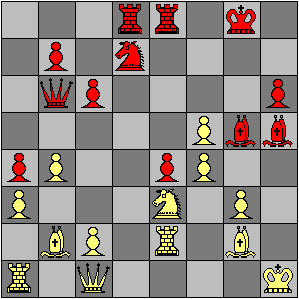
|
| after 30.f3-f4 |
|
|
Kasparov resigned game 2 in a position where he could have reached a draw by perpetual check. Many observers suspected that he was spooked by the strength of his electronic opponent.
| Game 2 : Deep Blue - Kasparov |
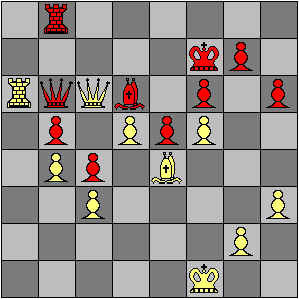
|
| after 45.Ra8-a6? 1-0(?) |
| (45...Qe3 should draw) |
|
|
In game 3 Kasparov opened with the rare 1.d3 and achieved an advantage, but was unable to find a win. The game ended in a draw.
| Game 3 : Kasparov - Deep Blue |
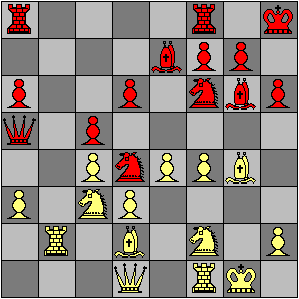
|
| after 23.Be3-d2 |
|
|
Game 4 was also a draw. Kasparov played an unusual variation of the Caro Kann and achieved an advantage, but was unable to win a rook and pawn endgame,
| Game 4 : Deep Blue - Kasparov |
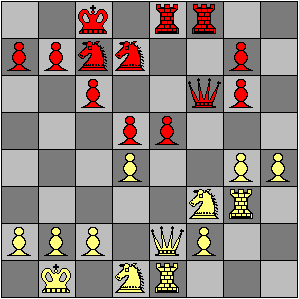
|
| after 20...e6-e5 |
|
|
Kasparov again had the upper hand in game 5, but was unable to break the machine's tenacious defense.
| Game 5 : Kasparov - Deep Blue |
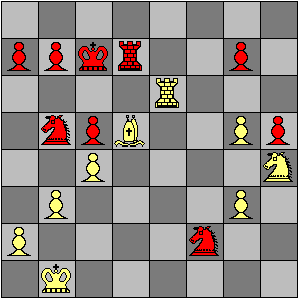
|
| after 36...Nd6-b5 |
|
|
The sixth game was one of the shortest defeats of Kasparov's career. He played a known line in the Caro Kann, an opening which had never been part of his repertoire. For reasons known only to himself, he allowed a crushing knight sacrifice on the eighth move which has always won for White and which was probably included in Deep Blue's opening database. After struggling in a hopeless game, he resigned on his 19th move.
A machine had accomplished what no person has ever done - defeat Kasparov in a chess match.
| Game 6 : Deep Blue - Kasparov |
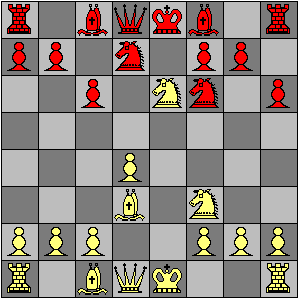
|
| after 8.Ng5-e6(xP) |
|
|
After the game Kasparov said, "I was surprised by the second game. It had a profound impact on my psychology." He blamed his loss on a lack of prematch preparation, and was apparently caught off guard by the serious approach IBM took for the match. He also accused Deep Blue of having had human assistance during the match and demanded to see the software logs.
Many world class chess players agreed that Kasparov did not play like Kasparov. His strategy had been to get the machine out of its opening database as early as possible, to play middle game positions where strategy is more important than tactics, and to reach endgames where qualitative factors outweigh the quantitative.
In games 3 through 5, Kasparov apparently fell victim to the well known horizon factor, which is a double edged sword peculiar to a computer's brute force approach to chess. It works against the machine when disadvantageous positions are pushed outside the software's search tree by introducing inconsequential moves into the critical branches. It works for the machine when the inconsequential moves make the likely result harder to find for the human.
Deep Blue's team won 700.000 US$; Kasparov won 400.000 US$. IBM estimated that the corporation received 50.000.000 US$ worth of publicity during the match.
|
WCC Index |
Results |
|
Previous |
Next |